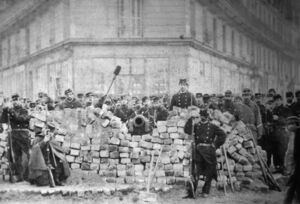Brumley Rebellion
| Brumley Rebellion | |||||||
|---|---|---|---|---|---|---|---|
 Men of the Teutonberg Militia pose by a captured barricade | |||||||
| |||||||
| Belligerents | |||||||
|
| ||||||
| Commanders and leaders | |||||||
|
Alexander II |
Winton Ó Rodagh | ||||||
| Strength | |||||||
| 64,600 troops (overall) | approx. 70,000 at height | ||||||
| Casualties and losses | |||||||
| 1,028 killed, 3,101 wounded |
7,000 killed and wounded Most leaders executed | ||||||
The Brumley Rebellion was an attempted left-wing revolution on 14th November 1897 in Vionna-Frankenlisch and centred around the major industrial city of Brumley. Though initially successful, the so-called Brumley Commune was unable to raise support outside Brumley and a dogged defence by municipal police forces, the city's military garrison and local militia prevented the Commune's forces from taking control of the entire city. Relief forces from Frankenlisch and Grythshead were able to rescue government forces and put down the uprising, though low-level fighting carried on throughout most of November.
Background
March 1897 saw the surprise downfall of Lord Wooton's Liberal government in a mire of sex scandal and allegations of corruption. A scathing exposé in the National Journal, a Conservative-aligned newspaper, was published on 15th March and included testimony from several Frankenlisch courtesans, private letters from prominent Liberal MPs, and a selection of illicit photographs taken of Wooton's Foreign Minister, Sir Desmond Lachlain, in the intimate company of the Marienberger Comtesse de Trielle. Other newspapers swiftly picked up the stories and, soon enough, even those sympathetic to the Liberal government were forced to join the attack on Wooton's government. Attempts to suppress the story only made the situation worse for Wooton's government and, utterly blindsided by the media onslaught, Lord Wooton and several of his ministers resigned in shame. A close friend of Wooton, King Alexander II was privately shocked and appalled by the attitude of the media but was obliged to dissolve Parliament and call an election. The election of April 1897 saw the Liberals roundly defeated and replaced by a Conservative government headed by Frederick Whilcott.
Strikers in the rich coal mining regions of Caerayereth, Erin, Middlebrooke, and Karanante, were in negotiations with Wooton's government and a settlement was nearly reached when the election occurred and Whilcott's new government broke off negotiations. As a result, the strikes continued into mid-May when they were called off due to strike-breaking action and near destitution on the part of the striking workers. The City of Brumley was, and remains, the industrial heart of the Kingdom of Frankenlisch and the working-class population were outraged by reports of strike-breakers and news (albeit exaggerated) of the Braedwardith Shootings - in which thirty strikers were shot on a march.
Combat on the Outskirts
Fort Atranta
Brumley Fort
At 9:30am, the Erinite Countess Nola O'Duffy banded 800 rebels together in a warehouse in the Upper Harbour District, most of them sailors or dockyard workers. The Countess was well respected by the socialist community and was quickly elected as a leader of the uprising. She stressed the need for arms and ammunition and declared that the rebels should capture Brumley Fort, which overlooked Brumley and Harbour Bay. The rebels surged towards the fort and overpowered the disorganised gate guards. They rampaged through the fort, killing many members of the Brumley Territorial Reserve Brigade and broke into the fort's two armouries and arsenal. The rebels captured the fort entirely intact and the armouries contained twelve-thousand infantry rifles, just over a hundred thousand rounds of ammunition, bayonets. More importantly, the fort's arsenal contained twelve mortars, four field guns and, most important of all, six Clement Guns.
Royal Counterattack
King Alexander II, the new King of Vionna-Frankenlisch, was told about the uprising on the third day of a summit, held in honour of his coronation and the death of his brother, Richard. He quickly formed a force of six thousand men in the Frankenlisch Military District, named the Royal Force, which he commanded personally. Consisting of four battalions of the Royal Frankenlisch Rifles, a battalion of the Royal Hastings Fusiliers, the Imperial Palace Yeomanry and thirty-two guns of the Imperial Zianian Artillery. 160 militiamen from villages on the road to Brumley joined the force, led by the Baron Barrow. The Quenminese ambassador and several Quenminese military advisors came along with the King. At 18:00 on the fourteenth, the King established his headquarters at the village of St Illebins, a settlement that overlooked Brumley from the heights surrounding the city. By seven, the Imperial Zianian Artillery had deployed and the infantry were busily engaged in entrenching the field guns. The IZA began bombarding Brumley Fort at 19:15 but the bombardment was slow due to a lack of ammunition.
For every moment the fort remained in rebel hands, more rifles filtered out into the city, arming more rebels. The fort had yet to turn its guns on the loyalist positions but it was only a matter of time. Alexander grouped the four battalions of the Frankenlisch Rifles together and placed them under the command of Brigadier Matthew Fosworth. The Frankenlisch Rifles were ordered to enter the city and carve a path to the Central Industrial District where loyalists were defending William Altman's factory, under heavy attack by socialist rebels. The Hastings Fusiliers and the militiamen were ordered to make an attack against the fort. Both of these actions were planned for the morning of the fifteenth.
At 08:00 on the fifteenth, the Royal Frankenlisch Rifles entered Brumley from the North-East, meeting little resistance. The Hastings Fusiliers marched against the fort, their right flank guarded by the militia. Led by Colonel John Quilter, the attack was met with accurate rifle fire and repulsed with twenty casualties, suffering from lack of equipment. By 11:00, the RFR had reached Industry Plaza, the direct middle of the industrial area of Brumley. North of that point was the Central Industrial District and, almost immediately, Fosworth's troops were met with snipers and roadblocks and barricades.